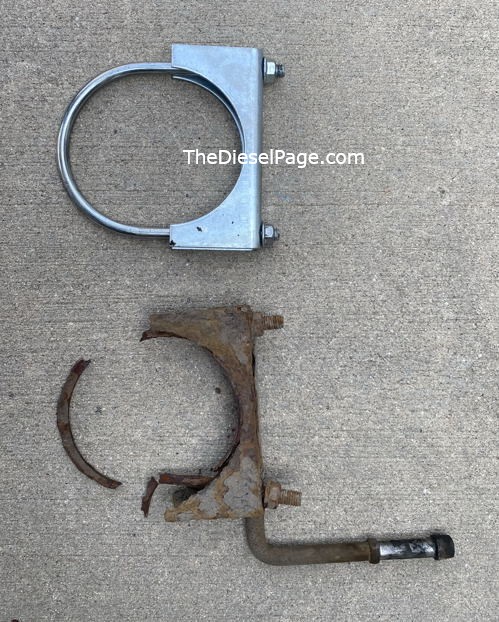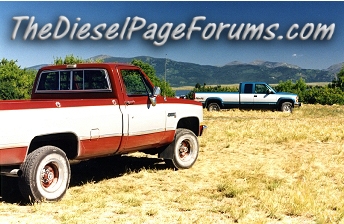Rust
We're here to save you money and provide the information you need to do the best job possible.
By TheDieselPage.com
Rust... Every year, millions of vehicles suffer many more millions of dollars in damage due to rust. As awful as the cosmetic damage is, rust can even make your vehicle unsafe to drive and you may not even be aware of it. I don't know of a single instance where someone dismantled their truck, sandblasted-stripped-repainted-recoated the metal parts and then reassembled everything to correct the damage caused by rust - just not worth it. What we'll do here is show you how to easily and inexpensively treat this rust problem.
I owned this '55 Chevy back in the early 1970s. It had spent most of its life somewhere in Oregon before I owned it. Being near to the coast, the bottom edge of both doors had rusted out. I replaced both doors soon after I bought it, but there were no other rusted-through areas on the body. It was pretty solid otherwise. However, I was concerned about the quarter panels and the inside areas below the rear roll-up windows. Not having the time, money or the inclination to do a full restoration, I removed the interior trim panels below the rear side windows and squirted a little motor oil into the creases and tight spaces inside the body that were likely to develop rust. Later, in the 1980s, I did the same thing for a 1982 GMC 6.2L diesel pickup I owned at that time. These trucks could develop a rust-through problem in the bottom edge of the doors and in the cab corners. Neither the '55 nor the '82 GMC had another rust problem in the sheet metal while I owned them. The motor oil, as I discovered, will wick into the tightest of spaces, and will continue to prevent rust for years.
The lead-in photo shows you what the rear differential and axle looks like in a 16-year-old truck that had been driven through 15 winters where road de-icer had been used on the highways. The appearance of rust is so disappointing to an automotive enthusiast. The above photo shows what the application looks like just a few minutes after having been lightly sprayed with a motor oil/solvent solution. The shiny appearance quickly goes away as the solution gases off and acquires a light coating of road dust.
This photo shows that the oil spray had turned the frame rail and leaf springs flat black not long after having been treated. This frame rail had significant areas of ugly surface rust just prior to being treated.
This image is of a 2005 GMC 2500HD LLY Duramax from Canada that had been exposed to road de-icer every winter since new. The arrow in this image points to a fuel line. You can also see that the front driveshaft should be replaced to avoid a structural failure. Proactively treating these areas once a year, like that described here, would prevent the damage from occurring.
If you're an automotive enthusiast and live in the northern tier of America you know how awful road de-icer can be - and not just for your truck. Magnesium Chloride is also an environmental hazard. This photo shows a large Ponderosa Pine near where I live that was killed by MC. Snow slush saturated with magnesium chloride was thrown up by a snow plow onto this Pine during the prior winter, which killed this and dozens of other Pine trees that were apparently located too near this Montana highway.
The motor oil I use for rust treatment here at thedieselpage.com is the blackest used diesel crankcase oil I could find. The blacker the better. I saved a gallon of used oil a while back for just this purpose. Most any spray bottle will work, such as an old Windex or Armor All spray bottle, but a spray bottle with a selectable spray pattern is best. Use a solvent to thin the motor oil so the solution will spritz. I've always used diesel fuel as the solvent, but a non-flammable solvent might be an alternative - perhaps like that used for an automotive parts washing system.
While spraying, I do my best to avoid coating any rubber/neoprene part or the disc brake rotors and calipers with an oily solution. I have seen 6.5L diesel motor mounts and rubber isolated serpentine crank pulleys that were damaged (softened) by motor oil. Spray just enough to lightly wet the rusty steel surface you're concerned about. A drip indicates you're using too much. Use a little common sense. Wear gloves and safety glasses. The solution mentioned here will stop brake line rust wherever it's applied. Depending on conditions and location, the oily spray will provide rust protection for up to a year or longer. You may need to re-coat some areas every year or two - a small price to pay to keep rust from ruining your truck or making it unsafe to drive.
Is this safe? I've heard many stories through the years of trucks developing fuel and/or ATF/oil leaks that wound up saturating the underneath of the truck. Even I had an automatic transmission cooler line fail once just ahead of the engine on the passenger side (exhaust side) of my Lil Red Duramax conversion truck, which caused ATF to coat the under-surface of the truck front to rear. Other than a mess to clean up, there was no other concern.
Additionally, one summer more than 20 years ago I was called in to a local garage to look at a diesel Suburban that had developed a fuel leak on the engine, a big leak. The Suburban had been driven more than 120 miles on the Interstate with that fuel leak. The leaking fuel had stripped the undercoating off the underside of the vehicle from the engine compartment to the rear axle, and the fuel had been dripping onto the exhaust system the whole way. There was no fire.
Not to put too fine a point on this issue, but most LB7 Duramax owners have likely read about what happens when an injector fuel return line leak occurs beneath the valve covers of the LB7 (first gen Duramax) engine... It results in a fuel leak into the crankcase, which eventually overfills the oil level to a point of spewing out the crankcase vent system. This coats the entire underneath of the truck and any trailer you're towing with a diesel fuel and oil mixture. No fires have been reported here in thedieselpage.com as a result of a fuel return line leak beneath the valve covers. That being said, always use your own judgment about whether you believe what is being suggested here to help prevent rust is safe for your situation.
As was mentioned earlier in this article, here at thedieselpage.com I've been treating rust using this method for decades, and I've not found a better, easier, more convenient or less expensive way to prevent rust from ruining a vehicle or making it unsafe to drive. If there's another solution to this rust problem - one that works as well and is as easy/cheap, let me know and I'll update this page with your suggestions. In the meantime, try what I'm suggesting here on a small rusty area on your truck that is well out of view. I find it amazing how well this works, but try it, then give it a week, and let us here in thedieselpage.com forums know what you think.
Copyright - TheDieselPage.com
Related: TheDieselPage.com Article - Room For Improvement







 Reply With Quote
Reply With Quote


